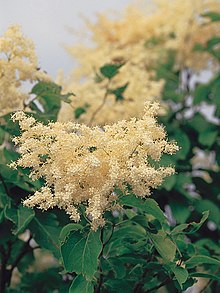Syringa reticulata, the Japanese tree lilac,[1] is a species of flowering plant in the family Oleaceae. It is native to eastern Asia, and is grown as an ornamental in Europe and North America.
| Japanese tree lilac | |
|---|---|

| |
| Scientific classification | |
| Kingdom: | Plantae |
| Clade: | Tracheophytes |
| Clade: | Angiosperms |
| Clade: | Eudicots |
| Clade: | Asterids |
| Order: | Lamiales |
| Family: | Oleaceae |
| Genus: | Syringa |
| Species: | S. reticulata
|
| Binomial name | |
| Syringa reticulata | |
Description
editIt is a deciduous small tree growing to a height of 12 m (39 ft), rarely to 15 m (49 ft), with a trunk up to 30 cm (12 in), rarely 40 cm (16 in) in diameter; it is the largest species of lilac, and the only one that regularly makes a small tree rather than a shrub. The leaves are elliptic-acute, 2.5–15 cm (0.98–5.91 in) long and 1–8 cm (0.39–3.15 in) broad, with an entire margin, and a roughish texture with slightly impressed veins. The flowers are white or creamy-white, the corolla with a tubular base 0.16–0.24" (4–6 mm) long and a four-lobed apex 0.12–0.24" (3–6 mm) across, and a strong fragrance; they are produced in broad panicles 5–30 cm (2.0–11.8 in) long and 3–20 cm (1.2–7.9 in) broad in early summer. The fruit is a dry, smooth, brown capsule (15–25 mm long), splitting in two to release the two winged seeds.[2][3][4][5]
Distribution
editSyringa reticulata is found in northern Japan (mainly Hokkaidō), northern China (Gansu, Hebei, Heilongjiang, Henan, Jilin, Liaoning, Nei Mongol, Ningxia, Shaanxi, Shanxi, Sichuan), Korea, and far southeastern Russia (Primorye).[2][3][6]
Names
editChinese: 暴馬丁香; pinyin: Bào mǎ dīngxiāng; Japanese: ハシドイ (丁香花), romanized: hashidoi
The Latin specific epithet reticulata means "netted".[7]
Subspecies
editThere are three subspecies:[2]
- Syringa reticulata subsp. reticulata (syn. Syringa japonica (Maxim.), also syn. S. amurensis var japonica (Maxim.) Franch et Sav.- Ligustrina japonica (Maxim.) ) - Japan.
- Syringa reticulata subsp. amurensis (Rupr.) P.S.Green & M.C.Chang (syn. S. reticulata var. mandschurica (Maxim.) H.Hara) - Northeastern China, Korea, southeastern Russia.
- Syringa reticulata subsp. pekinensis (Rupr.) P.S.Green & M.C.Chang - North-central China. It has very distinct reddish-brown peeling bark.
References
edit- ^ NRCS. "Syringa reticulata". PLANTS Database. United States Department of Agriculture (USDA). Retrieved 7 December 2015.
- ^ a b c Flora of China: Syringa reticulata
- ^ a b Hanaki Kawahara Gardens: Syringa reticulata Archived 2012-02-09 at the Wayback Machine (in Japanese; google translation)
- ^ Mitomori: Syringa reticulata (in Japanese; google translation)
- ^ Huxley, A., ed. (1992). New RHS Dictionary of Gardening. Macmillan ISBN 0-333-47494-5.
- ^ Kew World Checklist of Selected Plant Families Syringa reticulata
- ^ Harrison, Lorraine (2012). RHS Latin for Gardeners. United Kingdom: Mitchell Beazley. ISBN 978-1845337315.
